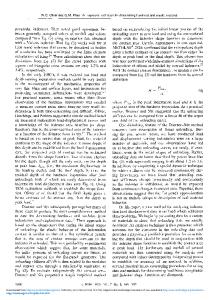An improved instrumented indentation technique for single microfibers
- PDF / 452,667 Bytes
- 9 Pages / 584.957 x 782.986 pts Page_size
- 71 Downloads / 452 Views
Kenneth E. Strawheckera) U.S. Army Research Laboratory, Weapons and Materials Research Directorate, APG, Maryland 21005 (Received 13 January 2014; accepted 27 March 2014)
We describe an improved experimental approach for characterizing the elastic modulus and hardness of single microfibers through instrumented indentation. A sample mounting technique on a curved surface is presented that ensures contact between an unmodified fiber and substrate. The indentation analysis considers three separate corrections to the well-known Oliver and Pharr method: (i) overestimation of the projected contact area due to sample curvature, (ii) overestimation of projected contact area due to substrate curvature, and (iii) underestimation of fiber stiffness due to the structural compliance of the sample. The method is applied to four types of high performance ballistic fibers: KM2 Plus, Twaron, AuTx, and Dyneema; the results are presented according to both the modified analyses as well as the standard Oliver and Pharr analysis. The modified analyses resulted in an increase in the elastic modulus and hardness of up to 35 and 60%, respectively, compared to the Oliver–Pharr method. The technique has the potential to be applied to single microfilaments under various environmental conditions that may otherwise be compromised by traditional fiber mounting methods.
I. INTRODUCTION
High performance fibers are used in a variety of applications due to their light weight, high strength, and environmental stability.1–3 The fibers are typically synthesized using a melt- or wet-spinning process followed by a hot drawing step.3,4 The result is a highly oriented microfibrillar structure that leads to a highly anisotropic mechanical behavior, with excellent properties occurring along the fiber axis but properties up to two orders of magnitude lower in the radial direction.5,6 While the structure of these materials are well known,3,7,8 the relationship between fiber microstructure and local/global mechanical properties is less understood. Mechanical properties of fibers are typically studied through global measurement techniques, such as microtensile testing and microcompression tests.5,9 The bulk mechanical behavior is thought to be controlled by the size and number of structural defects that occur within the drawn material.10–12 Less studied are the local mechanical properties of the fibers which can be used to explain the hierarchical relationships that exist due to the micro-/nanoscale morphology and defects. Instrumented indentation, commonly referred to as ‘nanoindentation,’ is an increasingly popular technique
for probing local mechanical properties of a sample.13,14 During indentation, the force and displacement are continuously monitored with nanonewton and nanometer resolution, respectively, making the technique attractive for applications in which small volumes of materials need to be examined. To date, the restrictions in applying instrumented indentation techniques to characterize microfibers have included (i) challenges in rigidly securing fibers to a su
Data Loading...











